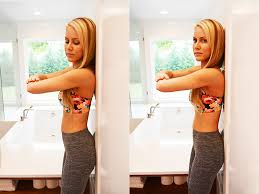
by admin | Apr 27, 2016 | Uncategorized
I picked up this little gem on a workshop at the weekend and I’ve been using it in class all week. It’s a fabulous little tool to check you are in the best alignment for spine health.
In optimal alignment the ribs should sit directly above the pelvis. But in our modern lifestyles the muscles of our chest, shoulders and arms have become tight and restrict our range of movement. As our bodies need to maintain an upright position it adjusts by lifting our ribs forwards in front of our hips.

In the photo on the left, with the use of the mirror, compared to the picture on the right you can see the mid-back (where the bra strap/heart rate monitor would be) is not against the wall. Try it yourself. Stand a couple of inches from a wall, place your thigh bones toward the wall, letting your tailbone relax. Then bring your shoulders, arms, and back of the head against the wall. There should be a small space underneath your waist where your low back naturally curves in, but your middle back (the ribs/bra strap/heart rate monitor area) should also be touching the wall. When the alignment is correct, as in the picture on the right, if all the dots were joined on both sides it would give a square shape.
The increased distance between the hips and ribs stretches some of the front ‘core’ muscles, causing them to become lengthened and weaker, whilst the muscles at the back of the body become shortened and weakened. The shorter muscles of the spine reduce the space between the discs and can increase the rate of their degeneration.
So, to keep you ‘core’ strong and balanced keep square aware.
by admin | Mar 9, 2016 | Uncategorized
I shouldn’t just blame your phone, there are so many reasons why we start to develop a forward head posture or ‘chin poke’. Driving, long term computer use, need to wear glasses or using bi-focals or vari-focals. Our modern lifestyle is very forward facing and tends to draw us with it.
Our heads weight 10-12lbs, for every inch the head comes forward of the spine it can increase the weight of the head on the spine by a further 10lbs.
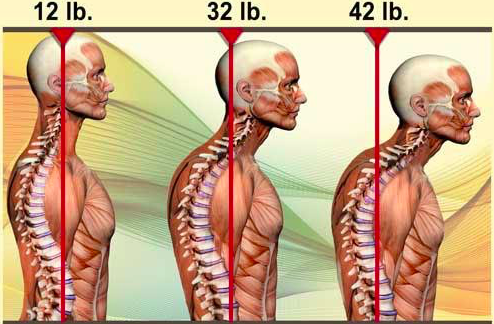
A forward head posture is when the head is help forwards of the posture line. It would look like a person’s ears are in front of their shoulders. This can have the effect of disrupting the balance of the muscles that support the head on top of the neck.
Specifically the muscles at the font of the neck become lengthened and less supportive, whilst the muscles at the back become shortened and overworked. Imagine your head and neck like a mast being supported by wires (the muscles). If some of the wires become slack then the other wires will have to work harder to keep the mast upright.
This disruption can cause changes in the space between the bones on the neck (vertebra) reducing the range of movement – noticed you can’t see you’re your blind spot as easily recently? – and increasing risk to wear and tear. It also increases our risk to injury. For example, when subjected to a force a muscle that is ‘tight’ doesn’t have the elasticity it needs to respond to that force. Therefore, it is more likely to become damaged.
So, how can we help correct a head forward posture?
- Stop lifting your chin. Imagine that your chin is resting on the shelf. To stand tall feel like you’re lengthening up the back of your neck, like a piece of string pulling the crown of your head to the ceiling.
- When using mobile devices e.g. texting on your phone, bring the device to eyeline rather than your eyeline down to the device.
- Adjust your computer monitor so that the centre of the screen is directly in your eyeline.
- Use the exercise below to start to rebalance the muscles of the neck.
by admin | Feb 23, 2016 | Uncategorized
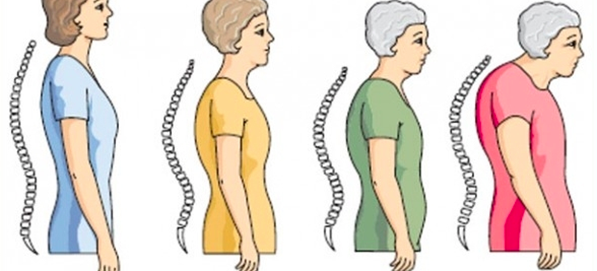 Did you know that your skeleton is 1/10th of your body mass and 10% of your bone is renewed each year. Our bone mass peaks between the ages of 20 and 40 years and from the ages of 30-35 years there is an average decrease of 1% in done density per year. This can be accelerated up to 6% decrease in bone mass for females post menopause due to the more significant changes in hormone levels.
Did you know that your skeleton is 1/10th of your body mass and 10% of your bone is renewed each year. Our bone mass peaks between the ages of 20 and 40 years and from the ages of 30-35 years there is an average decrease of 1% in done density per year. This can be accelerated up to 6% decrease in bone mass for females post menopause due to the more significant changes in hormone levels.
I’m sure we’re all aware that I’m hinting at Osteoporosis. Osteoporosis is defined as being below -2.5, when measure on a DEXA machine. The term Osteopenia is also give to someone whose bone density is slightly below average but not at osteopenic levels (-1 to -2.5 DEXA). The loss of bone density in itself is not painful. However, the fractures that occur because of it are and the resulting change in body shape due to the healing process of the fractures can impact on breathing, digestion and movement. Unfortunately, we only find out there may be an issue once and incident has occurred. One the positive side, it’s never too late to start addressing you’re bone health. Loss of bone density can be significantly slowed through modification of lifestyle, nutrition and increase in or change in activity types and levels.
National Guidelines from UK and World authorities vary slightly but agree on taking a minimum of 150 minutes per week of regular moderate to vigorous intensity aerobic exercise. Most importantly the Department of Health indicate that there should be 2 days per week of strength conditioning and balance. The benefits of these activities help prevent falls and the associated fractures that could result from falling. Weight bearing exercises also encourage the bones to strengthen and the muscles to support the skeleton better. It also encourages better and confidence in movement patterns i.e. reduced risk to tripping ad better support if there is a loss of balance.
The best news if that if you’re attending a Modern Pilates session at Ormkirk Pilates you are meeting the recommendations for preventing or reducing the impact of reduce bone density. The standing, balancing and arm loading work we do are weight bearing exercises and they develop your movement patterns. We strengthen the supporting muscles of the spine, reduce the weight of the head on the spine and learn to move to give maximum support to it in our movement.
If you have been told that you have osteopenia or osteoporosis and would like to support your body more or you don’t know but would like to prevent it from occurring and want more information drop me a line at info@ormskirkpilates.co.uk
by admin | Feb 8, 2016 | Uncategorized
Hyperextension is the movement of a joint past its normal range. All our joints have an optimal range of movement, which they are designed to function optimally within. They are also designed to be able to a little bit beyond that range as a mechanism to protect from injury.
If the knee joint is hyperextended the shin bones are pulled backwards in relation to the foot.
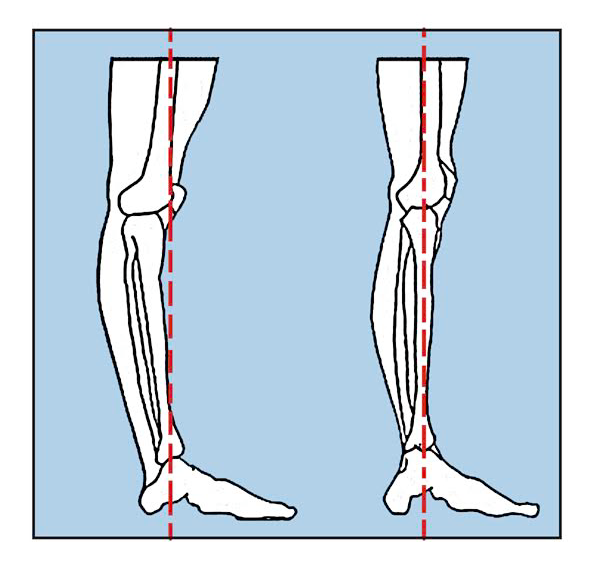
The bones of the body are meant to stack one of top of the other in order to transfer ‘forces’ through the joints and the body. If the knee joint is hyperextended, it puts greater strain on the ligaments at the back of the knee and has the impact of unbalancing the muscles above and below the joint. Ultimately the whole body is affected as our lower body doesn’t work in isolation of the upper body.
If our daily habits assist in the hyperextension of the knee, the joint will gradually become lax. This laxity can then transpose into our movement when standing and walking. So, when walking our leg straightens as our heel strikes the ground and transfer forces up the leg the bones of the leg should stay in parallel. If there is laxity at the joint at this point the knee effectively moves backwards, closes the space of the knee joint and increases the likelihood of wear and tear of the joint.
Signs you might be a ‘knee extender’?
- Loss of definition of the vertical creases at the back of your knees.
- Your legs look like they’re bending backwards.
If you recognise that you’re a ‘knee extender’ what can you do to break the habit?
- Keep checking your knee position when standing. They should be soft and feel relaxed but not bent.
- Take shorter steps when walking. This will also help you move from your core as opposed to your extremities.
by admin | Dec 1, 2015 | Uncategorized |
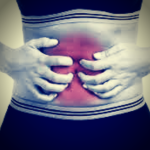 For the past couple of months I’ve been learning more about nutrition. Not just the eat 5 fruit and veg a day (you do, don’t you?) but getting at the nuts (get it?) and bolts. The macro-nutrients and the implications for our bodies.
For the past couple of months I’ve been learning more about nutrition. Not just the eat 5 fruit and veg a day (you do, don’t you?) but getting at the nuts (get it?) and bolts. The macro-nutrients and the implications for our bodies.
Many factors make up our nutritional needs picture. Our individual biological requirements can vary fourfold between different people, the stressors that we are exposed to i.e. smoking exposure or types of medications taken and the overall health of an individual. When there is a discrepancy between the needs of the body an our input, the body is unable to repair itself sufficiently and inflammation occurs, which can lead to degeneration of any system within the body.
But if you have a healthy diet that shouldn’t matter? Well not necessarily. Did you know that a cauliflower has ½ the vitamin C content and watercress 88% less iron that they contained 50 years ago. Bananas need to ripen on the trees to fully develop their nutritional content but they are picked to be shipped when green. Supermarkets are allowed to cold store apples for 6 months before going on sale. The nutritional value of an apple halves for every month it is stored. So, it turns out that eating a ‘healthy’ diet may still not be as nutritious as we need it to be.
Are you bamboozled? I was at this point. But don’t worry. There are many things that can be done to. Add a more veggies to your plate. Steam rather than boil, to keep as many of the nutrients as possible. Reduce the amount of wheat/gluten, dairy, caffeine, alcohol and sugar in the diet.
Let me know if you want to discuss any of this information further.




 Did you know that your skeleton is 1/10th of your body mass and 10% of your bone is renewed each year. Our bone mass peaks between the ages of 20 and 40 years and from the ages of 30-35 years there is an average decrease of 1% in done density per year. This can be accelerated up to 6% decrease in bone mass for females post menopause due to the more significant changes in hormone levels.
Did you know that your skeleton is 1/10th of your body mass and 10% of your bone is renewed each year. Our bone mass peaks between the ages of 20 and 40 years and from the ages of 30-35 years there is an average decrease of 1% in done density per year. This can be accelerated up to 6% decrease in bone mass for females post menopause due to the more significant changes in hormone levels.
 For the past couple of months I’ve been learning more about nutrition. Not just the eat 5 fruit and veg a day (you do, don’t you?) but getting at the nuts (get it?) and bolts. The macro-nutrients and the implications for our bodies.
For the past couple of months I’ve been learning more about nutrition. Not just the eat 5 fruit and veg a day (you do, don’t you?) but getting at the nuts (get it?) and bolts. The macro-nutrients and the implications for our bodies.
Recent Comments